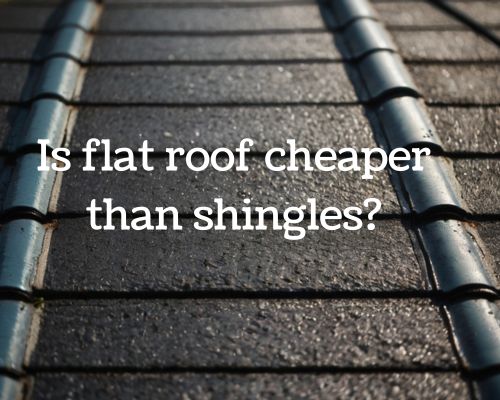
Is Flat Roof Cheaper Than Shingles?
A Cost Comparison Analysis
When it comes to roofing options, flat roofs and shingle roofs are two of the most popular choices. If you’re in the market for a new roof, you may be wondering which option is cheaper. The answer is not straightforward, as it depends on a variety of factors. With David Spade of Star Roofing West Palm Beach, we will explore the pros and cons of each option and help you determine which one is the most cost-effective for your specific situation.

Flat roofs are often associated with commercial buildings, but they are becoming increasingly popular for residential properties as well. One of the biggest advantages of flat roofs is their affordability. Flat roofs require fewer materials and less labor to install than shingle roofs, which can significantly reduce the overall cost of the project. Additionally, flat roofs are easier to maintain and repair, which can save you money in the long run. However, not all flat roofs are created equal, and some types may be more expensive than others.
Comparing Costs of Flat Roofs and Shingle Roofs
When it comes to roofing, one of the most important considerations is cost. Two of the most popular roofing options are flat roofs and shingle roofs. While both have their benefits, they differ significantly in terms of cost.
Initial Installation Costs
Flat roofs are generally more affordable than shingle roofs when it comes to initial installation costs. The average cost of a flat roof installation is between $4 and $6.94 per square foot, while shingle roofs can cost between $5.50 and $12 per square foot. This means that a flat roof installation for a 1,700-square-foot home would cost between $6,800 and $11,798, while a shingle roof installation for the same home would cost between $9,350 and $20,400.
However, the cost of installation can vary depending on factors such as the type of flat roof or shingle roof you choose, the size of your roof, and the complexity of the installation process.
Long-Term Expenses and Lifespan
While flat roofs may be cheaper upfront, they might end up costing more in the long run. Flat roofs have a shorter lifespan than shingle roofs, typically lasting between 10 and 20 years. Shingle roofs, on the other hand, can last between 15 and 30 years.
Additionally, flat roofs may require more maintenance and repairs over time, which can add to the overall cost. Shingle roofs are generally easier to maintain and repair, and individual shingles can be replaced as needed.
When it comes to long-term expenses, it’s also important to consider factors such as energy efficiency. Flat roofs are often less energy-efficient than shingle roofs, which can lead to higher heating and cooling costs over time.
Material and Durability Considerations
When it comes to flat roofs versus shingles, the choice of roofing material is a key consideration. There are various types of roofing materials available, each with their own pros and cons.
Types of Roofing Materials
Flat roofs can be covered with materials such as rubber, metal, asphalt shingles, modified bitumen, single-ply membrane, built-up roof, and composite shingles. Shingles, on the other hand, are typically made of asphalt, composite materials, or wood.
Rubber roofing is a popular choice for flat roofs, as it is durable and long-lasting. Metal roofing is another option, which is known for its energy efficiency and resistance to severe weather. Asphalt shingles are a common choice for sloped roofs due to their affordability and ease of installation.
Weather and Environmental Impact
Weather and environmental factors can impact the durability of roofing materials. Flat roofs are more prone to problems such as standing water, mold, and debris buildup, which can cause leaks and damage over time. Shingles, on the other hand, are more susceptible to damage from severe weather such as hail, wind, and fire.
Maintenance and Repair Factors
Maintenance and repair considerations should also be taken into account when choosing a roofing material.
Flat roofs require regular inspections and maintenance to prevent leaks and repairs.
Seams in flat roofing materials can be a weak point, as they are prone to leaks over time. Meanwhile, shingles may require occasional repairs due to damage from severe weather or debris buildup.
In summary, when choosing between a flat roof and shingles, the choice of roofing material is a critical factor to consider. Factors such as durability, weather and environmental impact, and maintenance and repair requirements should all be taken into account.
For any installation or maintenance work, you can have Star Roofing West Palm Beach do it for you.